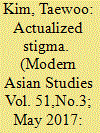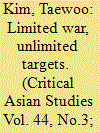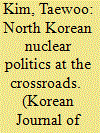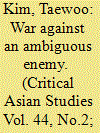|
|
|
Sort Order |
|
|
|
Items / Page
|
|
|
|
|
|
|
| Srl | Item |
| 1 |
ID:
153580


|
|
|
|
|
| Summary/Abstract |
During the Open Port period and Japanese colonial period (1876–1945), Koreans generally had a positive image of the United States. This positive view of the United States held by Koreans persisted until after liberation from Japanese colonial rule in 1945. The United States was a ‘liberator’ that saved the Koreans, and was viewed as ‘a cooperator’ with whom Korea was to solve its national task of establishing a new country. However, the concept of ‘American imperialist warmonger’ had begun to be promoted in North Korea from 1948–49. It was a concept advanced by the Soviet Union and the North Korean leadership. The negative image of the United States, which spread throughout North Korea from the early years of the Cold War, was merely a perplexing stigma lacking substantiated grounds. However, the experiences of the Korean War actualized the image of the United States as a ‘warmonger’ in the hearts of the North Korean people. Alleged indiscriminate aerial bombings, mass slaughters, sexual assaults, and arson attacks against Korean civilians became the most important reason for the expansion of intense sentiment. Anti-Americanism began to be systemized and routinized in every aspect of North Korean life after the Korean War.
|
|
|
|
|
|
|
|
|
|
|
|
|
|
|
|
| 2 |
ID:
115035


|
|
|
|
|
| Publication |
2012.
|
| Summary/Abstract |
In the early days of the Korean War, the U.S. Air Force (USAF) had a policy of precision bombing military targets only. Policy-makers in Washington, D.C., formulated this policy to ensure the protection of Korean civilians and to increase the effectiveness of their air operations. Senior USAF officers in Korea, however, were unhappy about the limitations placed on them by Washington. In their strategic air operations against targets in North Korea USAF officers followed Washington's precision bombing policy, but they insisted that USAF bombers be permitted to use incendiary bombs against population centers in North Korea. China's entry into the war in November 1950 led to a drastic change in the precision bombing policy. On 5 November 1950, when the UN forces began suffering defeat after defeat in battles with the new enemy, General Douglas MacArthur designated cities and villages in North Korea as "main bombing targets" and permitted the use of incendiary bombs, which had been used in attacks against Japanese cities during World War II. From that point until the end of the war, the USAF regarded North Korean cities and villages as their crucial targets as political and military occasion demanded.
|
|
|
|
|
|
|
|
|
|
|
|
|
|
|
|
| 3 |
ID:
053786


|
|
|
| 4 |
ID:
112946


|
|
|
|
|
| Publication |
2012.
|
| Summary/Abstract |
In the early months of the Korean War, close air support provided by the U.S. Air Force (USAF) fighter-bombers in the front-line areas significantly delayed the advance of the North Korean Army. This article shows, however, that U.S. pilots very quickly diverged from the original policy of precision bombing and began the indiscriminate and unrestricted bombing of villages, towns, and even refugees in the South Korean region. They did so for three reasons: (1) to deal with effective countermeasures being taken by the North Korean Army; (2) the short range of U.S. fighter-bombers taking off from bases in Japan; and (3) difficulties in finding clear targets. Civilian areas were not exempt because most USAF pilots regarded the people in civilian areas as enemy troops and villages were considered to be enemy shelters. In the early months of the Korean War, the Operations Analysis Office (OAO) of the USAF had already acknowledged that "in a certain number of cases the troops in question may have been civilians." This article draws on mission reports written by U.S. pilots and on OAO reports to make the case that the conduct of American fighter-bomber pilots during the Korean War needs serious reconsideration.
|
|
|
|
|
|
|
|
|
|
|
|
|
|
|
|
|
|
|
|
|